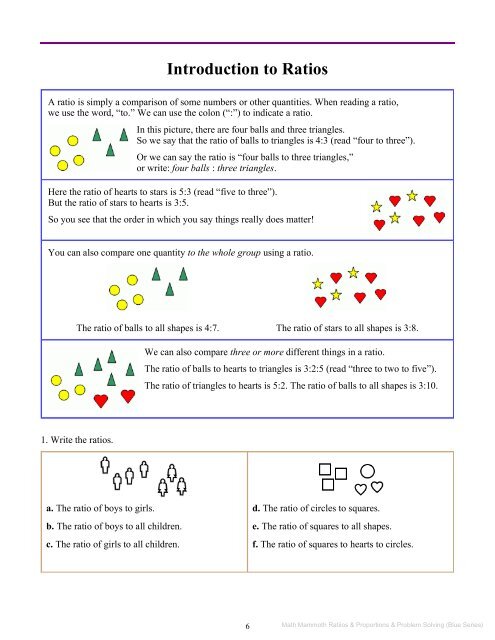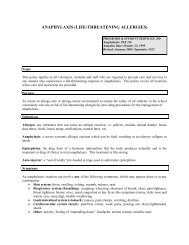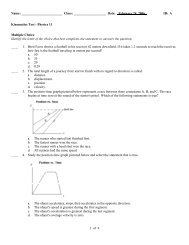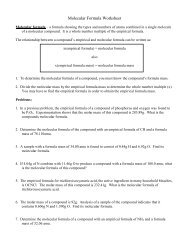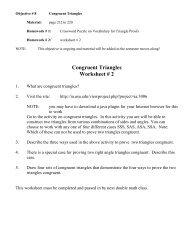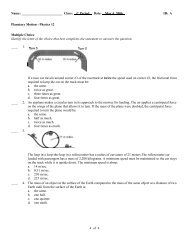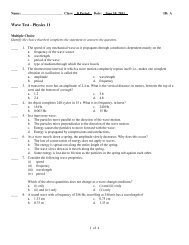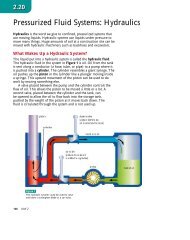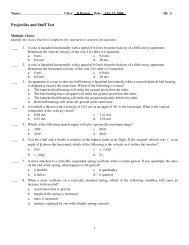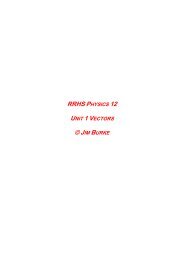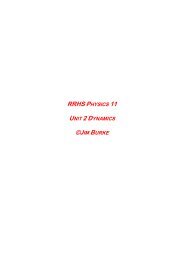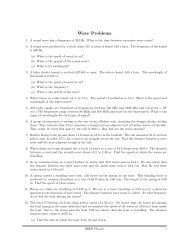Math Mammoth Ratios & Proportions & Problem Solving
Math Mammoth Ratios & Proportions & Problem Solving
Math Mammoth Ratios & Proportions & Problem Solving
You also want an ePaper? Increase the reach of your titles
YUMPU automatically turns print PDFs into web optimized ePapers that Google loves.
Introduction to <strong>Ratios</strong><br />
A ratio is simply a comparison of some numbers or other quantities. When reading a ratio,<br />
we use the word, “to.” We can use the colon (“:”) to indicate a ratio.<br />
In this picture, there are four balls and three triangles.<br />
So we say that the ratio of balls to triangles is 4:3 (read “four to three”).<br />
Or we can say the ratio is “four balls to three triangles,”<br />
or write: four balls : three triangles.<br />
Here the ratio of hearts to stars is 5:3 (read “five to three”).<br />
But the ratio of stars to hearts is 3:5.<br />
So you see that the order in which you say things really does matter!<br />
You can also compare one quantity to the whole group using a ratio.<br />
The ratio of balls to all shapes is 4:7. The ratio of stars to all shapes is 3:8.<br />
We can also compare three or more different things in a ratio.<br />
The ratio of balls to hearts to triangles is 3:2:5 (read “three to two to five”).<br />
The ratio of triangles to hearts is 5:2. The ratio of balls to all shapes is 3:10.<br />
1. Write the ratios.<br />
a. The ratio of boys to girls.<br />
b. The ratio of boys to all children.<br />
c. The ratio of girls to all children.<br />
d. The ratio of circles to squares.<br />
e. The ratio of squares to all shapes.<br />
f. The ratio of squares to hearts to circles.<br />
6 <strong>Math</strong> <strong>Mammoth</strong> Ratiios & <strong>Proportions</strong> & <strong>Problem</strong> <strong>Solving</strong> (Blue Series)
2. a. Draw a picture that represents the ratio<br />
3 small balls : 8 bigger balls.<br />
b. What is the ratio of bigger balls to all balls<br />
3. The ratio of green shirts to blue shirts is 3:5.<br />
a. What is the ratio of green shirts to all shirts<br />
b. What is the ratio of blue shirts to all shirts<br />
c. What is the ratio of blue shirts to green shirts<br />
4. The picture on the right shows some men and some women.<br />
a. What is the ratio of men to women<br />
b. Suppose that each symbol represents 6 people:<br />
How many men are there _______ How many women _______<br />
How many people in all _______<br />
We can use ratios even in the following situation:<br />
The ratio of girls to boys in a gym class is 3:2,<br />
and there are 25 students in all.<br />
Since the ratio is 3:2, we draw a diagram with 3 blocks to represent the number of girls and 2<br />
blocks to represent the number of boys. Thus we get five equal parts. Since there are 25 children<br />
in all, each block in the diagram represents 5 of them.<br />
So there are 15 girls and 10 boys.<br />
Draw a diagram for each situation, and solve it.<br />
5. The ratio of puppies to adult dogs in a kennel is 4:1.<br />
(Draw a diagram with 4 “puppy” blocks and one “adult” block.)<br />
If there are 80 dogs in total, how many dogs does each block represent<br />
How many of the 80 dogs are adults<br />
How many are puppies<br />
6. Marsha has 147 marbles in her bag, some white and<br />
some red. The ratio of white marbles to red ones is 3:4.<br />
How many marbles are red<br />
7. Anita and Shirley share a reward of $200 in a ratio of 3:5.<br />
How much does Anita get And what about Shirley<br />
7 <strong>Math</strong> <strong>Mammoth</strong> Ratiios & <strong>Proportions</strong> & <strong>Problem</strong> <strong>Solving</strong> (Blue Series)
We can present the same situation with the same information using either a picture or a diagram, and<br />
using either fractions or a ratio. Compare the examples below carefully.<br />
Picture or Diagram As Fractions As a Ratio<br />
3<br />
of the shapes are triangles.<br />
5<br />
The ratio of triangles<br />
2<br />
5 of the shapes are circles. to circles is 3:2.<br />
W W W W W B B B<br />
——— 72 ———<br />
5<br />
of the 72 socks are white.<br />
8<br />
The ratio of white to blue<br />
socks is 5:3. There are 72<br />
3<br />
8 of the 72 socks are blue. socks in all.<br />
8. “Translate” between a picture or diagram representation, fraction language, and ratio language.<br />
Picture or Diagram As Fractions As a Ratio<br />
a.<br />
of the shapes are squares.<br />
of the shapes are circles.<br />
The ratio of squares<br />
to circles is 4:5.<br />
b.<br />
2<br />
9 of the shapes are triangles. The ratio of triangles to<br />
rectangles is ___ : ___ .<br />
of the shapes are rectangles.<br />
c.<br />
of the ___ toy cars are Jack's.<br />
of the ___ toy cars are Rick's.<br />
The ratio of the number of<br />
Jack's cars to the number of<br />
Rick's cars is ___ : ___.<br />
There are ____ cars in all.<br />
d.<br />
of the ___ eggs are white.<br />
of the ___ eggs are brown.<br />
The ratio of white eggs<br />
to brown ones is 5:1.<br />
There are 3,600 eggs in all.<br />
8 <strong>Math</strong> <strong>Mammoth</strong> Ratiios & <strong>Proportions</strong> & <strong>Problem</strong> <strong>Solving</strong> (Blue Series)
9. 5/11 of the 1,287 hospital patients are females.<br />
a. What is the ratio of the female patients to all patients<br />
b. What is the ratio of the female patients to the male patients<br />
c. How many male patients are there<br />
10. Michael has 30 coins. 2/10 of Michael's coins are nickels,<br />
3/10 are dimes, and 5/10 are quarters.<br />
a. What is the ratio of Michael's nickels to dimes to quarters<br />
b. How many of each coin does he have<br />
See if you can solve this problem where we know the ratio of girls to boys,<br />
and the amount of girls, but not the total! The diagram will help.<br />
The ratio of girls to boys in a cooking club was 5:2.<br />
There were 20 girls.<br />
How many boys were there in the club<br />
How many members in all<br />
11. A jar has black and white beans in a ratio of 5:4.<br />
If there are 240 white beans, how many black beans are there<br />
How many beans all in all<br />
12. Peter's mom has made a rule that for each 2 library books<br />
Peter reads, he may also read 3 comic books. If Peter reads<br />
14 library books, how many comic books can he read<br />
13. If Peter hauls home a stack of 45 books and comic books<br />
according to mom's rule, how many of them are comic books<br />
14. In a cookie mix, we find chocolate chip cookies, vanilla cookies,<br />
and nut cookies in a ratio of 1:3:2. If a large sack contains<br />
210 vanilla cookies, how many nut cookies are there<br />
How many cookies in all<br />
9 <strong>Math</strong> <strong>Mammoth</strong> Ratiios & <strong>Proportions</strong> & <strong>Problem</strong> <strong>Solving</strong> (Blue Series)
<strong>Ratios</strong> and Fractions<br />
A ratio is simply a comparison of two numbers or other quantities.<br />
In the picture on the right, there are three hearts and five stars. To compare the hearts to the stars,<br />
we can say that the ratio of hearts to stars is 3:5 (read “three to five”).<br />
The ratio of stars to hearts is therefore 5:3 (read “five to three”).<br />
Notice that the order in which you mention the members of the ratio matters.<br />
We can use fractions, too, to describe this same picture, like this:<br />
3<br />
8 of the shapes are hearts. 5<br />
of the shapes are stars.<br />
8<br />
You can also compare one quantity to the whole group using a ratio.<br />
The ratio of circles to all shapes is 2:9.<br />
This is really similar to saying that 2 9<br />
3<br />
A theater has 110 plastic chairs in stacks.<br />
5<br />
We can present this same information, using<br />
a ratio instead of a fraction, like this:<br />
There are 110 chairs, some blue, some white.<br />
The ratio of blue chairs to white chairs is 3:2.<br />
of the shapes are circles.<br />
of the chairs are blue, and the rest are white.<br />
Notice carefully: The ratio does NOT mention that the chairs could be divided into five equal parts.<br />
But if you draw a diagram of the situation, you can easily see that. (Also note that 3 + 2 = 5.)<br />
1. Describe the images using ratios and fractions.<br />
a.<br />
The ratio of circles to pentagons is ____ : ____<br />
The ratio of pentagons to all shapes is ____ : ____<br />
of the shapes are pentagons.<br />
b.<br />
The ratio of diamonds to triangles is ____ : ____<br />
The ratio of triangles to all shapes is ____ : ____<br />
of the shapes are diamonds.<br />
c. Mr. Hyde owns 1,200 acres of land. of it is forest, and the rest of<br />
it is swampland. The ratio of the forest to swampland is ____ : ____.<br />
Of the land, ______ acres are forest, and ______ acres are swampland.<br />
10 <strong>Math</strong> <strong>Mammoth</strong> Ratiios & <strong>Proportions</strong> & <strong>Problem</strong> <strong>Solving</strong> (Blue Series)
2. “Translate” between a picture or diagram representation, “fraction language,” and “ratio language.”<br />
Picture or Diagram As Fractions As a Ratio<br />
a.<br />
of the shapes are hearts.<br />
of the shapes are diamonds.<br />
The ratio of hearts<br />
to diamonds is 1:5.<br />
b.<br />
3<br />
4 of the shapes are circles. The ratio of circles to<br />
triangles is ___ : ___ .<br />
of the shapes are triangles.<br />
c.<br />
of the 112 songs are slow.<br />
of the 112 songs are fast.<br />
The ratio of the number of<br />
slow songs to the number of<br />
fast songs is ___ : ___.<br />
There are ____ songs in all.<br />
3. A store got a shipment of 155 calculators.<br />
The ratio of basic calculators to scientific calculators was 4:1.<br />
a. Draw a model to represent the situation.<br />
b. What fractional part of the calculators were basic calculators<br />
c. How many scientific calculators were there<br />
4. There are 1,407 students in the local community college.<br />
The ratio of male students to female students is 3:4.<br />
a. Draw a model to represent the situation.<br />
b. What fractional part of the students are male<br />
c. How many male students are there<br />
5. A jar contains 810 beans. Five-sixths of the beans<br />
are white beans, and the rest are pinto beans.<br />
a. Draw a model to represent the situation.<br />
b. What is the ratio of white beans to pinto beans<br />
c. How many white beans are there<br />
11 <strong>Math</strong> <strong>Mammoth</strong> Ratiios & <strong>Proportions</strong> & <strong>Problem</strong> <strong>Solving</strong> (Blue Series)
6. Jack has a box filled with white and transparent marbles<br />
in a ratio of 2:5. He has 38 white marbles.<br />
a. Draw a model to represent the situation.<br />
b. What fractional part of the marbles are white<br />
c. How many marbles does he have in all<br />
You can also have a ratio that compares<br />
three (or more) different quantities.<br />
In the picture, the ratio of triangles to hearts to stars is 3:2:4.<br />
Using fractions, we say that<br />
3<br />
9 of the shapes are triangles, 2 9<br />
of the shapes are hearts,<br />
and 4 9<br />
of the shapes are stars.<br />
7. The ratio of circles to squares to triangles is 4:2:7.<br />
What fractional part of the shapes are squares<br />
8. If 4 11 of the shapes are hearts, 5 11<br />
of them are circles, and the rest are diamonds, then:<br />
a. What is the ratio of hearts to circles to diamonds<br />
b. What is the ratio of diamonds to circles to hearts<br />
9. A trail mix recipe contains raisins, nuts, and dried fruit (other than<br />
raisins) in a ratio of 4:3:1. If you want to make 2 pounds of the mix,<br />
then how many ounces of each ingredient do you need<br />
10. Another trail mix recipe contains raisins, nuts, and dried fruit<br />
in a ratio of 2:3:1. If you want to make 2 pounds of this recipe,<br />
then about how many ounces of each ingredient do you need<br />
11. A truck is carrying orange juice, peach juice, and pear juice<br />
bottles in a ratio of 7:3:2. If there are 1,200 pear juice bottles,<br />
then how many orange juice bottles are there<br />
How many bottles of juice in total does the truck contain<br />
12 <strong>Math</strong> <strong>Mammoth</strong> Ratiios & <strong>Proportions</strong> & <strong>Problem</strong> <strong>Solving</strong> (Blue Series)
<strong>Ratios</strong><br />
A ratio is a comparison of two numbers or quantities, using division. We can use a colon (“:”)<br />
to indicate a ratio. We can also express the ratio using the word “to” or write it as a fraction.<br />
The ratio of balls to triangles is 5:4.<br />
The ratio of balls to triangles is 5 to 4.<br />
The ratio of balls to triangles is 5 4 .<br />
The two numbers in the ratio are called the first term and the second term of the ratio.<br />
The order in which the quantities are mentioned does matter. In this picture, the<br />
ratio of balls to triangles is 4:2, and the ratio of triangles to balls is 2:4.<br />
We can also compare a part to the whole. The ratio of balls to all shapes is 4:6.<br />
We can simplify ratios just like we simplify fractions. The ratio of balls<br />
to triangles is 6 2 = 3 . We say that 6:2 and 3:1 are equivalent ratios.<br />
1<br />
The simplified ratio 3:1 means that for each three balls, there is one triangle.<br />
When we simplify the ratio of hearts to stars to the lowest terms,<br />
18<br />
we get<br />
12 = 3 . Or, 18:12 = 3:2. This means that for each<br />
2<br />
three hearts, there are two stars.<br />
We could also simplify like this: 18:12 = 9:6. Those two ratios<br />
are equivalent, but neither is simplified to the lowest terms.<br />
1. Write the ratios. Also, simplify them to the lowest terms.<br />
a. The ratio of hearts to stars is =<br />
b. The ratio of hearts to stars is =<br />
The ratio of stars to hearts is =<br />
The ratio of hearts to all shapes is =<br />
2. Write the ratios using the colon. Simplify the ratios if possible.<br />
a. 15 to 20 b. 16 to 4<br />
c. 25 to 10 d. 13 to 30<br />
13 <strong>Math</strong> <strong>Mammoth</strong> Ratiios & <strong>Proportions</strong> & <strong>Problem</strong> <strong>Solving</strong> (Blue Series)
3. Write the equivalent ratios. Think about equivalent fractions.<br />
a.<br />
5<br />
2 = 20 b. 3 : 4 = 9 : ____ c. 16 : 18 = ____ : 9 d. 5 1 = 4<br />
e. 2 to 100 = 1 to ________ f. ____ to 40 = 3 to 5 g. 5 : ____ = 1 to 20<br />
4. a. Draw a picture where there are a total of six balls,<br />
and for each two balls, there are five squares.<br />
b. Write the ratio of all balls to all squares,<br />
and simplify this ratio to the lowest terms.<br />
c. Write the ratio of all shapes to balls,<br />
and simplify this to the lowest terms.<br />
5. Look at the picture of the triangles and circles. If we drew more triangles and circles<br />
in the same ratio, how many circles would there be …<br />
a. … for 9 triangles<br />
b. … for 15 triangles<br />
c. … for 300 triangles<br />
We can also form ratios using quantities with various units. For example, in the ratio<br />
5 km<br />
5 km : 8 km, both terms contain the unit “km”. We can then cancel that unit out:<br />
8 km = 5 8 .<br />
6. Write the ratios of the quantities using the fraction line. Simplify the ratios. In most of the problems,<br />
you need to convert the one quantity so it has the same measuring unit as the other.<br />
a. 2 kg and 400 g<br />
b. 200 ml and 2 L<br />
2 kg<br />
400 g = 2,000 g<br />
400 g = 2,000<br />
400<br />
= 5 1<br />
c. 4 cups and 2 quarts d. 800 m and 1.4 km<br />
e. 120 cm and 1.8 m f. 3 ft 4 in and 1 ft 4 in<br />
14 <strong>Math</strong> <strong>Mammoth</strong> Ratiios & <strong>Proportions</strong> & <strong>Problem</strong> <strong>Solving</strong> (Blue Series)
If the two terms in the ratio have different units, then the ratio is also called a rate.<br />
For example, “5 miles to 40 minutes” is a rate. It is comparing the quantities “5 miles” and<br />
“40 minutes,” perhaps for the purpose of giving us the speed at which a person is walking.<br />
5 miles<br />
We can also write this rate as 5 miles : 40 minutes or<br />
or 5 miles per 40 minutes.<br />
40 minutes<br />
The word “per” signifies the same as the colon or the fraction line. This rate can also be<br />
simplified:<br />
5 miles<br />
40 minutes<br />
=<br />
1 mile<br />
8 minutes<br />
. So the rate is also 1 mile per 8 minutes.<br />
Example. Simplify the rate “15 pencils per 100 ¢”. Solution:<br />
15 pencils<br />
100 ¢<br />
=<br />
3 pencils<br />
20 ¢<br />
.<br />
7. Fill in the missing numbers to form equivalent rates.<br />
a.<br />
2 cm<br />
30 min<br />
=<br />
15 min<br />
=<br />
45 min<br />
b.<br />
$72<br />
8 hr<br />
=<br />
1 hr<br />
=<br />
10 hr<br />
c.<br />
1/4 mi<br />
10 min<br />
=<br />
1 hr<br />
=<br />
5 hr<br />
d.<br />
$84.40<br />
8 hr<br />
=<br />
2 hr<br />
=<br />
10 hr<br />
8. Express these rates in lowest terms.<br />
a. $44 : 4 hr b. $30 : 8 kg<br />
9. The rate of pencils to<br />
dollars remains the same.<br />
Fill in the table.<br />
Pencils Dollars<br />
1<br />
c. 420 km : 8 hr d. 16 apples for $12<br />
2<br />
3 0.72<br />
6<br />
7<br />
8<br />
10. The rate of miles to gallons remains constant. Fill in the table.<br />
Miles 345<br />
Gallons 1 2 3 4 5 10 15 50<br />
11. A car travels at a constant speed of 80 km/hour.<br />
This means the rate of kilometers to hours<br />
remains the same. Fill in the table.<br />
Km 10 20 80 100 150 200 500<br />
Minutes<br />
15 <strong>Math</strong> <strong>Mammoth</strong> Ratiios & <strong>Proportions</strong> & <strong>Problem</strong> <strong>Solving</strong> (Blue Series)
<strong>Solving</strong> <strong>Problem</strong>s Using Equivalent <strong>Ratios</strong><br />
Example. If Jake can ride his bike to a town that is 21 miles away in 45 minutes,<br />
how far can he ride in 1 hour<br />
Let’s form an equivalent rate. However, it’s not easy to<br />
go from 45 minutes to 60 minutes (1 hour). Therefore,<br />
let’s first figure the rate for 15 minutes, which is easy.<br />
Why Because to get from 45 minutes to 15 minutes<br />
you simply divide both terms of the rate by 3.<br />
Then from 15 minutes, we can easily get to 60 minutes: Just multiply both terms by 4.<br />
This is now easy to solve:<br />
21 miles<br />
45 minutes = 7 miles<br />
15 minutes = 28 miles<br />
60 minutes<br />
÷ 3 × 4<br />
21 miles<br />
45 minutes = miles<br />
15 minutes = miles<br />
60 minutes<br />
÷ 3 × 4<br />
. He can ride 28 miles in 1 hour.<br />
1. If Jake can ride 8 miles in 14 minutes, how long will he take to ride 36 miles<br />
Use the equivalent rates below.<br />
8 miles<br />
14 minutes<br />
=<br />
4 miles<br />
minutes =<br />
36 miles<br />
minutes<br />
2. Write the equivalent rates.<br />
a.<br />
15 km<br />
3 hr<br />
=<br />
1 hr<br />
= 15 min<br />
= 45 min<br />
b.<br />
$6<br />
45 min<br />
=<br />
15 min<br />
=<br />
1 hr<br />
=<br />
1 hr 45 min<br />
c.<br />
3 in<br />
8 ft<br />
=<br />
2 ft<br />
=<br />
12 ft<br />
=<br />
20 ft<br />
d.<br />
115 words<br />
2 min<br />
=<br />
1 min<br />
=<br />
3 min<br />
3. A car can go 50 miles on 2 gallons of gasoline.<br />
a. How many gallons of gasoline would the car need for a trip of 60 miles<br />
Use the equivalent rates below.<br />
50 miles<br />
2 gallons = 5 miles<br />
gallons =<br />
60 miles<br />
gallons<br />
b. How far can the car travel on 15 gallons of gasoline<br />
(Hint: First consider the case with just 1 gallon of gasoline.)<br />
16 <strong>Math</strong> <strong>Mammoth</strong> Ratiios & <strong>Proportions</strong> & <strong>Problem</strong> <strong>Solving</strong> (Blue Series)
Example. You get 20 erasers for $1.90.<br />
How much would 22 erasers cost<br />
We cannot easily find a number by which to multiply to get<br />
from 20 to 22. It is possible, but we will solve this problem<br />
in a different way.<br />
We will first figure out the cost of just 2 erasers! To<br />
find that, divide the price by 10. Then, from 2 erasers<br />
to 22 erasers, the cost will increase 11-fold:<br />
11 × $0.19 = $2.09. So 22 erasers would cost $2.09.<br />
Another way to come up with the same answer is just to add $0.19<br />
(the cost of 2 erasers) to $1.90 (the cost of 20 erasers). Yet another<br />
way is to find the cost of 1 eraser first and multiply that cost by 22.<br />
× <br />
20 erasers 22 erasers<br />
=<br />
$1.90<br />
<br />
× <br />
÷ 10 × 11<br />
20 erasers 2 erasers 22 erasers<br />
=<br />
=<br />
$1.90 $ 0.19 $<br />
÷ 10 × 11<br />
4. On the average, Scott makes a basket nine times out of twelve shots when he is practicing.<br />
How many baskets can he expect to make when he tries 200 shots<br />
9 baskets<br />
12 shots<br />
=<br />
5. You get 30 pencils for $4.50.<br />
How much would 52 pencils cost<br />
30 pencils<br />
$4.50<br />
=<br />
6. A train travels at a constant speed of 80 miles per hour.<br />
a. How far will it go in 140 minutes Use equivalent rates.<br />
80 miles<br />
1 hour<br />
=<br />
b. How long will it take for the train to travel 50 miles Use equivalent rates.<br />
80 miles<br />
1 hour<br />
=<br />
7. In a poll of 1,000 people, 640 said they liked blue.<br />
a. Simplify this ratio to the lowest terms.<br />
b. Assuming the same ratio holds true in another group of 125 people,<br />
how many of those people can we expect to like blue<br />
17 <strong>Math</strong> <strong>Mammoth</strong> Ratiios & <strong>Proportions</strong> & <strong>Problem</strong> <strong>Solving</strong> (Blue Series)


